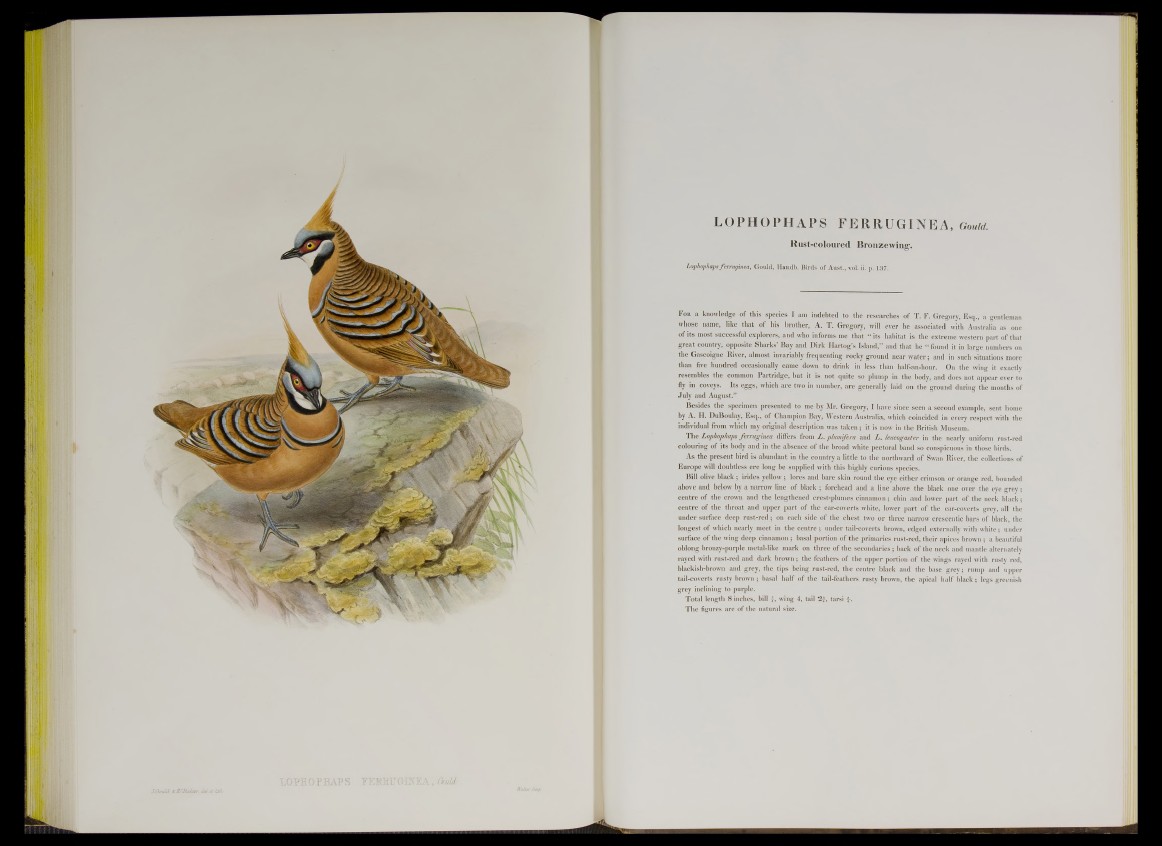
J.QoahL kRCRuhter. dd/. et> hffu
LOPHOPHAPS FERRUGINEA, Gould.
Rust-coloured Bronzewing1.
Lophophaps ferruginea, Gould, Handb. Birda of Aust., vol. ii. p. 137,
Fob a knowledge of this species I am indebted to the researches of T. F. Gregory, Esq., a gentleman
whose name, like that of his brother, A. T. Gregory, will ever be associated with Australia as one
of its most successful explorers, and who informs me that “ its habitat is the extreme western part of that
great country, opposite Sharks’ Bay and Dirk Hartog’s Island,” and that he “ found it in large numbers on
the Gascoigne River, almost invariably frequenting rocky ground near water and in such situations more
than five hundred occasionally came down to drink in less than half-an-hour. On the wing it exactly
resembles the common Partridge, but it is not quite so plump in the body, and does not appear ever to
fly in coveys. Its eggs, which are two in number, are generally laid on the ground during the months of
July and August.”
Besides the specimen presented to me by Mr. Gregory, I have since seen a second example, sent home
by A. H. DuBoulay, Esq., of Champion Bay, Western Australia, which coincided in every respect with the
individual from which my original description was taken; it is now in the British Museum.
The Lophophaps ferruginea differs from L . phmifera and L . leucogaster in the nearly uniform rust-red
colouring of its body and in the absence of the broad white pectoral band so conspicuous in those birds.
As the present bird is abundant in the country a little to the northward of Swan River, the collections of
Europe will doubtless ere long be supplied with this highly curious species.
Bill olive black ; irides yellow; lores and bare skin round the eye either crimson or orange red, bounded
above and below by a narrow line of black; forehead and a line above the black one over the eye g re y ;
centre of the crown and the lengthened crest-plumes cinnamon; chin and lower part of the neck black;
centre of the throat and upper part of the ear-coverts white, lower part of the ear-coverts grey, all the
under surface deep rust-red; on each side of the chest two or three narrow crescentic bars of black, the
longest of which nearly meet in the c en tre; under tail-coverts brown, edged externally with white; under
surface of the wing deep cinnamon ; basal portion of the primaries rust-red, their apices brown ; a beautiful
oblong bronzy-purple metal-like mark on three of the secondaries; back of the neck and mantle alternately
rayed with rust-red and dark brown; the feathers of the upper portion of the wings rayed with rusty red,
blackish-brown and grey, the tips being rust-red, the centre black and the base grey; rump and upper
tail-coverts rusty brown ; basal half of the tail-feathers rusty brown, the apical half black; legs greenish
grey inclining to purple.
Total length 8 inches, bill t, wing 4, tail , tarsi f .
The figures are of the natural size.